
Electoral history of Barbara Boxer.

Electoral history of Barbara Boxer.
| Party | Candidate | Votes | % | |
|---|---|---|---|---|
| Democratic | Barbara Boxer | 96,379 | 52.3 | |
| Republican | Dennis McQuaid | 82,128 | 44.6 | |
| Libertarian | Howard C. Creighton | 3,191 | 1.7 | |
| Peace and Freedom | Timothy Allen Albertson | 2,366 | 1.3 | |
| Total votes | 184,064 | 100.0 | ||
| Democratic hold | ||||
| Party | Candidate | Votes | % | |
|---|---|---|---|---|
| Democratic | Barbara Boxer (incumbent) | 162,511 | 67.9 | |
| Republican | Douglas Binderup | 71,011 | 29.7 | |
| Libertarian | Howard C. Creighton | 5,574 | 2.3 | |
| Total votes | 239,096 | 100.0 | ||
| Democratic hold | ||||
| Party | Candidate | Votes | % | |
|---|---|---|---|---|
| Democratic | Barbara Boxer (incumbent) | 142,946 | 73.8 | |
| Republican | Franklin Ernst III | 50,606 | 26.1 | |
| Total votes | 193,552 | 100.0 | ||
| Democratic hold | ||||
| Party | Candidate | Votes | % | |
|---|---|---|---|---|
| Democratic | Barbara Boxer (incumbent) | 176,645 | 73.3 | |
| Republican | William Steinmetz | 64,174 | 26.6 | |
| Total votes | 240,819 | 100.0 | ||
| Democratic hold | ||||
| Party | Candidate | Votes | % | |
|---|---|---|---|---|
| Democratic | Barbara Boxer (incumbent) | 137,306 | 68.1 | |
| Republican | Bill Boerum | 64,402 | 31.9 | |
| Total votes | 201,708 | 100.0 | ||
| Democratic hold | ||||
| United States Senate Democratic primary election in California, 1992 | ||||
|---|---|---|---|---|
| Party | Candidate | Votes | % | +% |
| Democratic | Barbara Boxer | 1,339,126 | 43.6 | |
| Democratic | Leo McCarthy | 943,229 | 30.7 | |
| Democratic | Mel Levine | 667,359 | 21.7 | |
| Democratic | Charles Greene | 122,954 | 4.0 | |
| Party | Candidate | Votes | % | ±% | |
|---|---|---|---|---|---|
| Democratic | Barbara Boxer | 5,173,467 | 47.9 | ||
| Republican | Bruce Herschensohn | 4,644,182 | 43.0 | ||
| American Independent | Jerome McCready | 373,051 | 3.5 | ||
| Peace and Freedom | Genevieve Torres | 372,817 | 3.5 | ||
| Libertarian | June R. Genis | 235,919 | 2.2 | ||
| Total votes | 10,799,436 | ||||
| Majority | 529,285 | 4.9 | |||
| Turnout | |||||
| Democratic hold | Swing | ||||
| United States Senate Democratic primary election in California, 1998 | ||||
|---|---|---|---|---|
| Party | Candidate | Votes | % | +% |
| Democratic | Barbara Boxer (incumbent) | 2,574,264 | 92.2 | |
| Democratic | John Pinkerton | 219,250 | 7.9 | |
| Party | Candidate | Votes | % | ±% | |
|---|---|---|---|---|---|
| Democratic | Barbara Boxer (incumbent) | 4,410,056 | 53.1 | +5.2 | |
| Republican | Matt Fong | 3,575,078 | 43.0 | 0.0 | |
| Libertarian | Ted Brown | 93,926 | 1.1 | −1.1 | |
| Reform | Timothy R. Erich | 82,918 | 1.0 | +1.0 | |
| American Independent | H. Joseph Perrin, Sr. | 54,699 | 0.7 | −2.8 | |
| Peace and Freedom | Ophie C. Beltran | 48,685 | 0.6 | −2.9 | |
| Natural Law | Brian M. Rees | 46,543 | 0.6 | +0.6 | |
| Total votes | 8,311,905 | ||||
| Majority | 834,978 | 10.1 | +5.2 | ||
| Turnout | |||||
| Democratic hold | Swing | +5.2 | |||
| Party | Candidate | Votes | % | ±% | |
|---|---|---|---|---|---|
| Democratic | Barbara Boxer (incumbent) | 6,955,728 | 57.7 | +4.6 | |
| Republican | Bill Jones | 4,555,922 | 37.8 | −5.2 | |
| Peace and Freedom | Marsha Feinland | 243,846 | 2.0 | +1.4 | |
| Libertarian | James P. Gray | 216,522 | 1.8 | +0.7 | |
| American Independent | Don J. Grundmann | 81,224 | 0.7 | 0.0 | |
| Total votes | 12,053,242 | ||||
| Majority | 2,399,806 | 19.9 | +9.8 | ||
| Turnout | |||||
| Democratic hold | Swing | +9.8 | |||
| United States Senate Democratic primary election in California, 2010 | ||||
|---|---|---|---|---|
| Party | Candidate | Votes | % | +% |
| Democratic | Barbara Boxer (incumbent) | 1,957,920 | 81.0 | |
| Democratic | Brian Quintana | 338,442 | 13.9 | |
| Democratic | Robert "Mickey" Kaus | 123,573 | 5.1 | |
| Party | Candidate | Votes | % | ±% | |
|---|---|---|---|---|---|
| Democratic | Barbara Boxer (incumbent) | 5,205,852 | 52.2 | −5.5 | |
| Republican | Carly Fiorina | 4,205,160 | 42.2 | +4.4 | |
| Libertarian | Gail Lightfoot | 174,537 | 1.8 | 0.0 | |
| Peace and Freedom | Marsha Feinland | 134,634 | 1.4 | −0.6 | |
| Green | Duane Roberts | 127,768 | 1.2 | +1.2 | |
| American Independent | Edward C. Noonan | 125,075 | 1.2 | +0.5 | |
| Total votes | 9,973,026 | ||||
| Majority | 1,000,692 | 10.0 | −9.9 | ||
| Turnout | |||||
| Democratic hold | Swing | -9.9 | |||

An election is a formal group decision-making process by which a population chooses an individual or multiple individuals to hold public office.
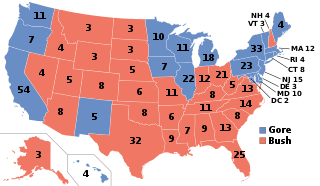
The 2000 United States presidential election was the 54th quadrennial presidential election, held on Tuesday, November 7, 2000. The Republican nominee, Governor George W. Bush of Texas, the eldest son of George H. W. Bush, narrowly defeated incumbent Democratic Vice President Al Gore. It was the fourth of five U.S. presidential elections, and the first since 1888, in which the winning candidate lost the popular vote, and is considered one of the closest U.S. presidential elections, with long-standing controversy about the result. Gore conceded the election on December 13.
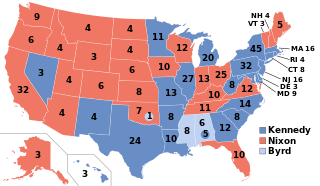
The 1960 United States presidential election was the 44th quadrennial presidential election, held on Tuesday, November 8, 1960. The Democratic ticket of Senator John F. Kennedy and his running mate, Senate Majority Leader Lyndon B. Johnson, narrowly defeated the Republican ticket of incumbent Vice President Richard Nixon and his running mate, U.N. Ambassador Henry Cabot Lodge Jr. This was the first election in which 50 states participated, marking the first participation of Alaska and Hawaii, and the last in which the District of Columbia did not. This made it the only presidential election where the threshold for victory was 269 electoral votes. It was also the first election in which an incumbent president—in this case, Dwight D. Eisenhower—was ineligible to run for a third term because of the term limits established by the 22nd Amendment.

The 1964 United States presidential election was the 45th quadrennial presidential election. It was held on Tuesday, November 3, 1964. Incumbent Democratic President Lyndon B. Johnson defeated Republican Senator Barry Goldwater in a landslide victory. Johnson was the fourth and most recent vice president to succeed the presidency following the death of his predecessor and win a full term in his own right. Johnson won the largest share of the popular vote for the Democratic Party in history at 61.1%. As of 2023, this remains the highest popular vote percentage of any candidate since the advent of widespread popular elections in 1824.

The Socialist Party of the United States of America is a socialist political party in the United States. SPUSA formed in 1973, one year after the Socialist Party of America splintered into three: Social Democrats, USA, the Democratic Socialist Organizing Committee (split), and SPUSA.

The 2008 United States presidential election was the 56th quadrennial presidential election, held on Tuesday, November 4, 2008. The Democratic ticket of Barack Obama, the junior senator from Illinois, and Joe Biden, the senior senator from Delaware, defeated the Republican ticket of John McCain, the senior senator from Arizona, and Sarah Palin, the governor of Alaska. Obama became the first African American to be elected to the presidency, as well as being only the third sitting United States senator elected president, joining Warren G. Harding and John F. Kennedy. Meanwhile, this was only the second successful all-senator ticket since the 1960 election and is the only election where both major party nominees were sitting senators. This was the first election since 1952 in which neither the incumbent president nor vice president was on the ballot, as well as the first election since 1928 in which neither ran for the nomination.
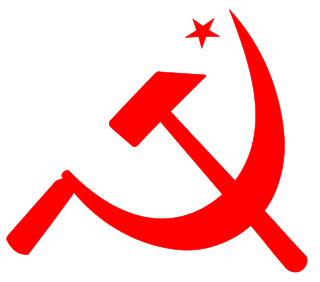
The Communist Party of India (Marxist) (abbreviated as CPI(M)) is a communist political party in India. It is the largest communist party in India in terms of membership and electoral seats, and one of the national parties of India. The party was founded through a splitting from the Communist Party of India in 1964 and it quickly became the dominant faction.
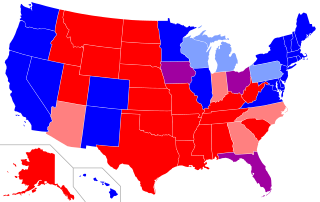
Starting with the 2000 United States presidential election, the terms "red state" and "blue state" have referred to US states whose voters vote predominantly for one party—the Republican Party in red states and the Democratic Party in blue states—in presidential and other statewide elections. By contrast, states where the vote fluctuates between the Democratic and Republican candidates are known as "swing states" or "purple states". Examining patterns within states reveals that the reversal of the two parties' geographic bases has happened at the state level, but it is more complicated locally, with urban-rural divides associated with many of the largest changes.

The 2004 United States presidential election was the 55th quadrennial presidential election, held on Tuesday, November 2, 2004. The Republican ticket of incumbent President George W. Bush and his running mate incumbent Vice President Dick Cheney was re-elected to a second term. They narrowly defeated the Democratic ticket of John Kerry, a United States senator from Massachusetts and his running mate John Edwards, a United States senator from North Carolina.

The 2012 United States presidential election was the 57th quadrennial presidential election, held on Tuesday, November 6, 2012. Incumbent Democratic President Barack Obama and his running mate, incumbent Vice President Joe Biden, were elected to a second term. They defeated the Republican ticket of former Governor of Massachusetts Mitt Romney and U.S. Representative Paul Ryan of Wisconsin.

The 2016 United States presidential election was the 58th quadrennial presidential election, held on Tuesday, November 8, 2016. The Republican ticket, businessman Donald Trump and Indiana governor Mike Pence, defeated the Democratic ticket of former secretary of state and First Lady of the United States Hillary Clinton and the junior senator from Virginia, Tim Kaine, in what was considered one of the biggest political upsets in American history. It was the fifth and most recent presidential election in which the winning candidate lost the popular vote. It was also the sixth and most recent presidential election in U.S. history in which both major party candidates were registered in the same home state; the others have been in 1860, 1904, 1920, 1940, and 1944.

The election of the president and the vice president of the United States is an indirect election in which citizens of the United States who are registered to vote in one of the fifty U.S. states or in Washington, D.C., cast ballots not directly for those offices, but instead for members of the Electoral College. These electors then cast direct votes, known as electoral votes, for president, and for vice president. The candidate who receives an absolute majority of electoral votes is then elected to that office. If no candidate receives an absolute majority of the votes for president, the House of Representatives elects the president; likewise if no one receives an absolute majority of the votes for vice president, then the Senate elects the vice president.

The 2016 United States House of Representatives elections were held on November 8, 2016, to elect representatives for all 435 congressional districts across each of the 50 U.S. states to the 115th United States Congress. Non-voting members for the District of Columbia and territories of the United States were also elected. These elections coincided with the election of President Donald Trump, although his party lost seats in both chambers of Congress. The winners of this election served in the 115th Congress, with seats apportioned among the states based on the 2010 United States census. In October 2015, the House elected a new Speaker, Republican Paul Ryan, who was re-elected in the new term. Democrat Nancy Pelosi continued to lead her party as Minority Leader. Elections were also held on the same day for the U.S. Senate, many governors, and other state and local elections.

The 2020 United States presidential election was the 59th quadrennial presidential election, held on Tuesday, November 3, 2020. The Democratic ticket of former vice president Joe Biden and the junior U.S. senator from California Kamala Harris defeated the incumbent Republican president, Donald Trump, and vice president, Mike Pence. The election took place against the backdrop of the global COVID-19 pandemic and related recession. The election saw the highest voter turnout by percentage since 1900, with each of the two main tickets receiving more than 74 million votes, surpassing Barack Obama's record of 69.5 million votes from 2008. Biden received more than 81 million votes, the most votes ever cast for a candidate in a U.S. presidential election.

The 2020 United States elections were held on Tuesday, November 3, 2020. The Democratic Party's nominee, former vice president Joe Biden, defeated incumbent Republican president Donald Trump in the presidential election. Despite losing seats in the House of Representatives, Democrats retained control of the House and gained control of the Senate. As a result, the Democrats obtained a government trifecta, the first time since the elections in 2008 that the party gained unified control of Congress and the presidency. With Trump losing his bid for re-election, he became the first president to have seen his party lose the presidency and control of both the House and the Senate since Herbert Hoover in 1932. This was the first time since 1980 that either chamber of Congress flipped partisan control in a presidential year, and the first time Democrats did so since 1948.

The 2018 United States House of Representatives elections were held on November 6, 2018, as part of the 2018 midterm elections during President Donald Trump's term, with early voting taking place in some states in the weeks preceding that date. Voters chose representatives from all 435 congressional districts across each of the 50 U.S. states to serve in the 116th United States Congress. Non-voting delegates from the District of Columbia and four of the five inhabited U.S. territories were also elected. On Election Day, Republicans had held a House majority since January 2011.
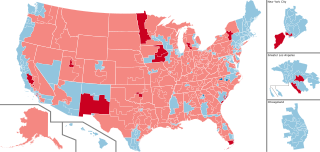
The 2020 United States House of Representatives elections were held on November 3, 2020, to elect representatives from all 435 congressional districts across each of the 50 U.S. states to the 117th United States Congress, as well as six non-voting delegates from the District of Columbia and the inhabited U.S. territories. Special House elections were also held on various dates throughout 2020.
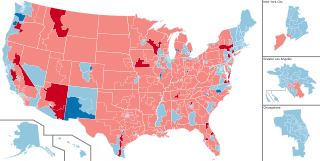
The 2022 United States House of Representatives elections were held on November 8, 2022, as part of the 2022 United States elections during incumbent president Joe Biden's term. Representatives were elected from all 435 U.S. congressional districts across each of the 50 states to serve in the 118th United States Congress, as well as 5 non-voting members of the U.S. House of Representatives from the District of Columbia and four of the five inhabited insular areas. Numerous other federal, state, and local elections, including the 2022 U.S. Senate elections and the 2022 U.S. gubernatorial elections, were also held simultaneously. This was the first election after the 2020 redistricting cycle.

The 2024 United States House of Representatives elections will be held on November 5, 2024, as part of the 2024 United States elections, to elect representatives from all 435 congressional districts across each of the 50 U.S. states, as well as 6 non-voting delegates from the District of Columbia and the inhabited U.S. territories to the United States House of Representatives. Special elections have also been held on various dates in 2024. Numerous other federal, state, and local elections, including the U.S. presidential election and elections to the Senate, will also be held on this date. The winners of this election will serve in the 119th United States Congress, with seats apportioned among the states based on the 2020 United States census.